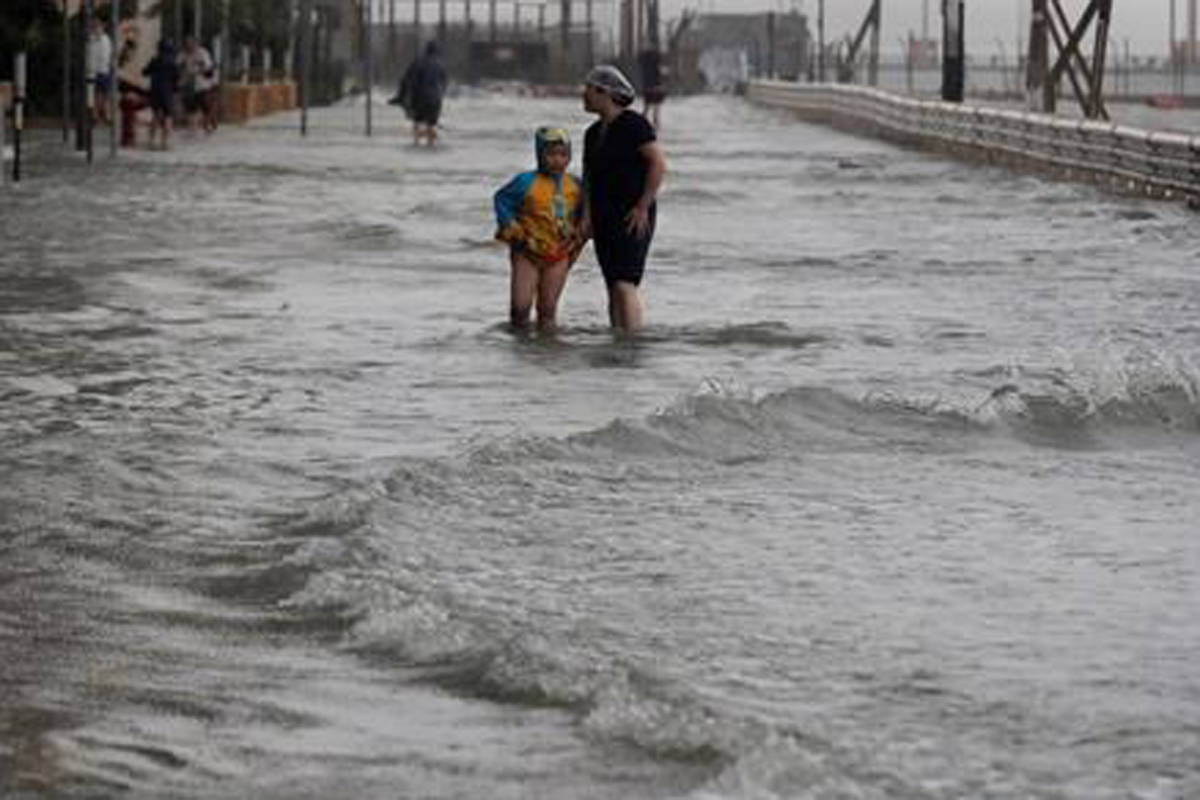Typhoon Mangkhut barrelled into southern China on Sunday after lashing the northern Philippines with strong winds and heavy rain that left at least 36 people dead and dozens more feared buried in a landslide.
Ahead of the massive typhoon, nearly half a million people had been evacuated from seven cities in China’s Guangdong province, the gambling enclave of Macau closed casinos for the first time and the Hong Kong Observatory warned people to stay away from the Victoria Harbour landmark, where storm surges battered the sandbag-reinforced waterfront.
READ MORE: Monster typhoon slams into northeastern Philippines
Mangkhut made landfall in the city of Taishan in Guangdong province at 5 p.m. local time, packing wind speeds of 162 kilometres (100 miles) per hour. State television broadcaster CGTN reported that surging waves flooded a seaside hotel in the city of Shenzhen.
Authorities in southern China had issued a red alert, the most severe warning, as the national meteorological centre said the densely populated region would face a “severe test caused by wind and rain” and urged officials to prepare for possible disasters.
On Sunday morning, the typhoon packed sustained winds of 155 kilometres (96 miles) per hour and gusts of up to 190 kph (118 mph). The Hong Kong Observatory said although Mangkhut had weakened slightly, its extensive, intense rainbands were bringing heavy downfall and frequent squalls.
Hundreds of flights were cancelled. All high-speed and some normal rail services in Guangdong and Hainan provinces were also halted, the China Railway Guangzhou Group Co. said.
In Hong Kong, a video posted online by residents showed the top corner of an old building break and fall off while in another video, a tall building swayed as strong winds blew.
The storm also broke windows, felled trees, tore bamboo scaffolding off buildings under construction and flooded areas with sometimes waist-high waters, according to the South China Morning Post.
The paper said the heavy rains brought storm surges of 3 metres (10 feet) around Hong Kong.
Hong Kong Security Minister John Lee Ka-chiu urged residents to prepare for the worst.
“Because Mangkhut will bring winds and rains of extraordinary speeds, scope and severity, our preparation and response efforts will be greater than in the past,” Lee said. “Each department must have a sense of crisis, make a comprehensive assessment and plan, and prepare for the worst.”
Hong Kong’s Cathay Pacific said all of its flights would be cancelled between 2:30 a.m. Sunday and 4 a.m. Monday. The city of Shenzhen also cancelled all flights between Sunday and early Monday morning. Hainan Airlines cancelled 234 flights in the cities of Haikou, Sanya, Guangzhou, Shenzhen and Zhuhai scheduled this weekend.
In Macau, next door to Hong Kong, casinos were ordered to close from 11 p.m. Saturday, the first time such action was taken in the city, the South China Morning Post reported. Macau suffered catastrophic flooding during Typhoon Hato last year, leading to accusations of corruption and incompetence at its meteorological office.
In Macau’s inner harbour district on Sunday, the water level reached 1.5 metres (5 feet) and was expected to rise further. The district was one of the most affected by floods from Typhoon Hato, which left 10 people dead.
In Fujian province and other parts of southern China, tens of thousands of fishing boats returned to port and construction work came to a stop.
In the northern Philippines, at least 40 people, mostly gold miners, are feared to have been trapped in a landslide in a mountain town that was pummeled by the typhoon before it blew out of the country late Saturday.
Police Superintendent Pelita Tacio told The Associated Press by phone that dozens of rescuers, including army troops and police, have dug out at least seven bodies from the huge mound of mud and rocks in the far-flung town of Itogon in Benguet province.
A part of the mountainside collapsed on the miners’ bunkhouses Saturday at the height of the typhoon’s onslaught, Tacio said, adding that rescuers were scrambling to pull out the body of another victim pinned by rocks and mud before she left the area Sunday.
At least 36 people, including the eight miners retrieved in Itogon, have died in typhoon-related incidents in the Philippines, mostly from landslides and collapsed houses.
Mangkhut made landfall on Saturday on the northeastern tip of Luzon island in the Philippines with sustained winds of 205 kilometres (127 mph) and gusts of 255 kph (158 mph).
The Philippines, which was battered by the typhoon on Saturday, appeared to have been spared the high number of casualties many had feared. In 2013, Typhoon Haiyan left more than 7,300 people dead or missing, flattened villages and displaced more than 5 million in the central Philippines. A massive evacuation ahead of Mangkhut helped lessen potential casualties, with about 87,000 people evacuating from high-risk areas, officials said.
Philippine National Police Director General Oscar Albayalde told The Associated Press that 20 people had died in the Cordillera mountain region, four in nearby Nueva Vizcaya province and another outside of the two regions. Three more deaths were reported in northeastern Cagayan province, where the typhoon made landfall.
The typhoon struck at the start of the rice and corn harvesting season in the Philippines’ northern breadbasket, prompting farmers to scramble to save what they could of their crops, Cagayan Gov. Manuel Mamba said.
___
Gomez reported from Manila, Philippines. Associated Press writers Aaron Favila and Joeal Calupitan in Tuguegarao, Philippines, and Gillian Wong in Beijing contributed to this report.
Vincent Yu And Jim Gomez, The Associated Press



